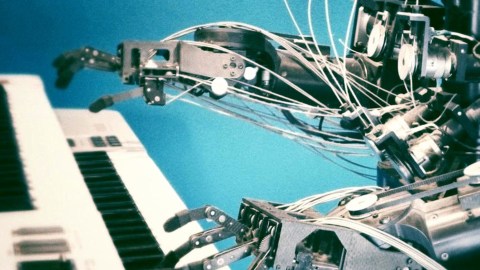Why the Automation Age might still need us around to work

- While automation and robots will displace millions of jobs, they’re poised to create millions more.
- Our current round of technological unemployment might just be a transitionary phase.
- The fear of automation has been around for decades.
Automation, and the rise of robots with superior A.I. promises to bring about a new era of industry and civilization. Our wildest sci-fi dreams could be realized within the century. Yet, the clamor and hoopla surrounding the topic has been overwhelmingly pessimistic — bordering on neo-Luddism at times. That is, the fear is that advancements in automation, artificial intelligence, and robotics will destroy millions — if not hundreds of millions — of livelihoods.
Some of these fears have a kernel of truth to them, all great technological epochs brings about an extreme shuffling around of the workforce. In the past, we’ve met new change and industrial disruption by evolving our skill sets and radically changing the nature of our lives. And for the best at that. The lowest among us live in greater opulence and comfort than the greatest kings of old — i.e. having A/C in the middle of summer.
But as the mass of humanity is often known to do, collectively we’ll shun radical change. Which is why it’s more common to see the pitfalls of the new robotic age in a deluge of headlines than to see the heralding of this exciting new era.
Currently, there is no singular concrete statistics to point to concerning the supposed oncoming automation job onslaught.
MIT Review has an ongoing chart of all the studies which have predicted how many jobs automation will destroy. Their conclusion is that “we have no idea how many jobs will actually be lost to the march of technological progress.”
Technological unemployment
The past two decades has seen its fair share of technological induced unemployment. No one is denying that fact. Over 2 percent of Americans, that is around 7 million people, lost their jobs in mass layoffs from 2004 to 2009. Many of these job losses were due to automation and manufacturing positions being moved overseas. While the larger mass of the populace enjoyed cheaper products, a good deal of American workers, mostly without college degrees, lost their careers.
Erik Brynjolfsson, a professor at the MIT Sloan School of Management, and coauthor Andrew McAfee have dug into these statistics over the years and come to the conclusion that advances in computer technology are behind the sluggish employment growth rates we’ve seen since the turn of the century.
Their most recent book covering the topic is: The Second Machine Age: Work, Progress, and Prosperity in a Time of Brilliant Technologies. During their earlier investigations they found that employment charts showed an upward trajectory that tracked evenly alongside productivity — starting a few years after World War II. The pattern continued, as an increase in jobs correlated to increases in productivity. That is, until the year 2000 when the lines started to diverge. Productivity was rising with greater economic growth, but there wasn’t an equivalency in job creation.
Brynjolfsson and McAfee have termed this phenomenon “The Great Decoupling.”
We’re at an impasse right now where our culture and employment force can’t keep up with this unprecedented technological growth.
“It’s the great paradox of our era. Productivity is at record levels, innovation has never been faster, and yet, at the same time, we have a falling median income and we have fewer jobs. People are falling behind because technology is advancing so fast and our skills and organizations aren’t keeping up,” Brynjolfsson says.
McAfee also stated in an interview with Harvard Business Review:
“There’s no economic law ensuring that as technological progress makes the pie bigger, it benefits everyone equally. Digital technologies can replicate valuable ideas, processes, and innovations at very low cost. This creates abundance for society and wealth for innovators, but it diminishes the demand for some kinds of labor.”
Same old story of worker obsolescence from past industrial eras, only this time it’s clothed in chrome and processors.
Predictions of an automated future
We’ve always oscillated between the dour and dark visions of a future turned upside down by automation or a near paradise tended to by our benevolent bots. As evidenced by the BBC video above, even children in the ’60s were thinking about the mind-boggling realities of a future dominated by robotics.
While we don’t have robot courts yet, or fully-autonomous fleets shuttling us anywhere we’d like, the things that robots may be able to do are staggering. This interactive NPR guide let’s you figure out how likely it is your job will be affected in the next 20 years. The usual suspects for disruption are all there — truck drivers, service workers, and so on.
Although, the current statistics paint a different picture. It’s nearly 2020 and the unemployment rate in the United States, as of June 2019, is 3.8 percent.
While some jobs are being lost to automation and other technologies, as it stands, we’re not seeing a huge percentage of Americans without some kind of work — as feared by many for decades. Perhaps our fears are unfounded and this transitionary period will turn out to be just that.
Future of employment
Alarmed like many others by the University of Oxford study that predicted a 47 percent job loss due to automation, journalist Andrés Oppenheimer traveled around the world to discover the truth for what beheld the future of work. In The Robots Are Coming! The Future of Jobs in the Age of Automation, Oppenheimer comes to the conclusion that we should be able to weather through this change just as we have in the past.
It’s going to require a lot of ingenuity coupled with the inevitable loss of countless professions becoming obsolete. We have already seen certain rote manual labor jobs either cease to exist or transition into new roles. This will become increasingly more commonplace within the next few decades.
A 2018 report from the World Economic Forum even suggested that, while we may displace 75 million jobs globally by 2022, we’ll create a net positive of 133 million new ones. The organization believes — with the current data in mind — that robots and algorithms will improve the productivity of existing jobs and create a number of new ones in the future.
Power of innovation
Some of the jobs we have today would be unthinkable to those living just 10 to 20 years ago. Technicians working in the cloud, full-stack developers, Instagram influencers, and so many more both technical and creative alike. These examples are just a mere handful of the novel positions being created almost every day.
Everyone needs to get in on this action somehow. We’re not all going to become programmers or engineers, but we can all start to think about the dynamics of work and employment in a much freer and future-oriented way.
Nothing is as powerful as an idea whose time has come — Victor Hugo
Universities are already getting in on the action. Recently, I interviewed the new Chief Innovation and Entrepreneurship Officer at UC Berkeley. The university’s foresight is helping them stay ahead of the technological disruption curve. They’re also focusing on imparting an innovator mindset to the student body at large. Institutions like this are indicative of the things to come.
Perhaps future workers won’t get a job — they’ll create their own.
No amount of angry hand waving or puerile legislation can stop this. We cannot even begin to fathom some of the otherworldly technologies and new career fields that’ll one day arise.





